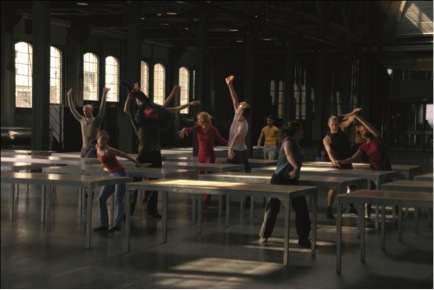[4] William Forsythe: One Flat Thing, Reproduced

1
A boy and a girl maneuver beside, over, and under a metal table, stretching, lifting, bending, kicking, twirling, leaping up and jumping down. They dance together; they dance apart. All around them are more tables, twenty in all, and more boys and girls, dancing around them, boys with boys, boys with girls, girls with girls, in such a variety of moves and gestures you cannot see them all at once. We know from analysis of moving pictures taken of the dance that it was not all chaos and improvisation; there were patterns suggested in what the dancers danced, there were hints of coordination, there were rhythms here and there counted off by the dancers themselves, clicking their tongues or shouting out loud. And the dancers walk away to the starting point, wait, and then come forward again eccentrically, first just one or two, then six, then five, then three...try to catch it all...well, you see what I mean.
the human body
pivoting past myriad
axis points, from knees
to shoulders, neck, and ankles
a marionette on strings
watching sapling limbs
in a strong wind, or breakers
crashing on the rocks
or plows turning over rows
of rolled-up furrow slices
as if someone tore
pages from a kid’s flick book
and rearranged them
so a hand grabs for a wrist
but comes up with an ankle
2
As the audience was filing out of the theater, I overheard a woman just ahead of us ask her husband, “But, what does it mean?” I was thinking along the same lines. Sure, it was interesting, you might even say it was exciting, but was there any story, anything like an idea? Was it, maybe, the report of what modern life is about? A critique of the pace of urban existence? And were the dancers, when they leapt up on the tables and then sat down and slid across, and pointed their left foot upward, trying to signal “exaltation?” But what if other dancers were doing the same thing, but meant all the time to say “impatience,” for example, then what? Wait, though, the choreographer must have intended certain emotions while designing and rehearsing the steps, but since he was not performing on stage, was not inside each body making the moves, does that even count?
not further mincing
words, these are an asylum’s
inmates on the loose
each one disembodying
their unutterable truths
unless you’re talking
about semaphore or sign
language, or a shrug
or a finger up to your eye
bodies really never speak
oh, what about when
his shoulders sag and his face
falls just before he
leaps in the air en dedans
singing “toot-toot tootsie, goodbye”?
3
Think of it as a classroom: the teacher is away, and the children are dancing and clowning around on the rows of desks, leaping over some, standing up on others, running around the room, posing and teasing and frolicking. They hear the clack-clack of the teacher’s heels coming back, and they all rush to their seats and fold their hands on the desks. But it was a false alarm, and one boy jumps up on his desk and starts tap dancing. “Hey,” he says, “look at me!” Another boy climbs up onto his desk and starts to run in place, stomping out some unheard rhythm in his head. “Look at me!” he shouts. “I’m a Yankee-Doodle Dandy.” Everyone’s slapping the desks and shouting, “Go! Go!” when the door opens, and the teacher walks in, looks around, and says, “So you think you can dance?” as she leaps up on her desk and begins a complicated ballet sequence while the children stare in rapture.
how close does dance come
to reiterating things
from the everyday?
do we imagine, but for
strict training, it could be us?
close your eyes and dream
of Teacher with no clothes on
there’s more than one way
to disobey the rules. What
if we danced all the time?
spontaneous dance
makes it so easy to say
where formal dancing
came from. watch for tapping toes
someone wriggling on a bench
Bio: Charles D. Tarlton
